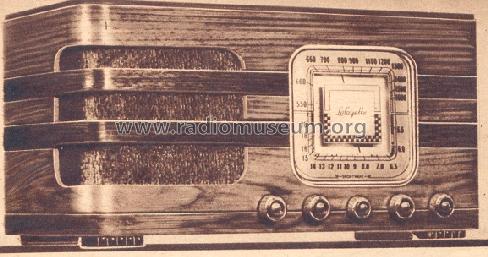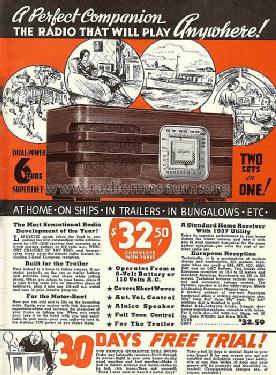- Country
- United States of America (USA)
- Manufacturer / Brand
- Lafayette Radio & TV Corp; New York (NY)
- Year
- 1937/1938
- Category
- Broadcast Receiver - or past WW2 Tuner
- Radiomuseum.org ID
- 92424
-
- alternative name: Wholesale Radio
- Number of Tubes
- 5
- Main principle
- Superheterodyne (common)
- Wave bands
- Broadcast and Short Wave (SW).
- Power type and voltage
- Line / Batteries (any type) / 6 volt storage battery / AC 110 Volt
- Loudspeaker
- Permanent Magnet Dynamic (PDyn) Loudspeaker (moving coil)
- Material
- Wooden case
- from Radiomuseum.org
- Model: D-32 - Lafayette Radio & TV Corp; New
- Shape
- Tablemodel, low profile (big size).
- Dimensions (WHD)
- 18.75 x 9.75 x 8.5 inch / 476 x 248 x 216 mm
- Notes
- The Lafayette model D-32 is featured as "two sets in one!" in the catalog no. 68: "The most sensational radio development of the year! Lafayette again takes the lead in presenting the first outstanding radio achievement for 1937 - ONE receiver that operates on a 6-volt storage battery or 110 volts a.c. without changes of any kind, and incorporates every up-to-the-minute radio feature including 2-band European reception. Built for the trailer, for the motor boat, a standard home receiver. Covers Short Waves, AVC, Alnico full-floating Permanent Magnet type speaker, Full tone control." For short wave band 18.4 to 52 meters and standard American broadcasts on 193 to 555 meters. Listprice $ 65.00 and Lafayette price $ 32.50. See details and summaries for the Lafayette catalog no. 68. We do not count ballast tubes and therefore we count 5, not 6 tubes here.
Some information about the Alnico speaker from Wikipedia: "Alnico is an acronym referring to alloys which are composed primarily of aluminium (symbol Al), nickel (symbol Ni) and cobalt (symbol Co), hence al-ni-co, with the addition of iron, copper, and sometimes titanium, typically 8-12% Al, 15-26% Ni, 5-24% Co, up to 6% Cu, up to 1% Ti, and the balance is Fe. Alnico alloys are ferromagnetic, and used to make permanent magnets. Before the development of rare earth magnets in the 1970s, they were the strongest type of magnet. Other trade names for alloys in this family are: Alni, Alcomax, Hycomax, Columax, and Ticonal.
The development of alnico began in 1931, when T. Mishima in Japan discovered that an alloy of iron, nickel, and aluminum had a coercivity (resistance to loss of magnetism) of 400 Oe, double that of the best magnet steels of the time."
- Price in first year of sale
- 33.00 $
- Literature/Schematics (1)
- Lafayette Radio Catalog (Lafayette Spring and Summer catalog no. 68 for 1937, page 113 and 1938 Lafayette Catalog Nº 69)
- Literature/Schematics (2)
- Table Top Radios Vol. 1 Stein 98 (page 105.)
- Author
- Model page created by Vitor Oliveira. See "Data change" for further contributors.
- Other Models
-
Here you find 1380 models, 1199 with images and 424 with schematics for wireless sets etc. In French: TSF for Télégraphie sans fil.
All listed radios etc. from Lafayette Radio & TV Corp; New York (NY)



